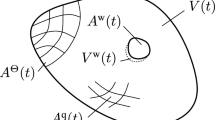Abstract
The wire feeding system for gas metal arc welding usually consists of a wire feeder and a torch. In many industries, the distance between the wire feeder and the torch is generally 3 m to 5 m. In a conventional wire feeder, a direct current (DC) motor is used for wire feeding. However, a significant problem with this system is the impossibility of feedback control because of inner or outer impedance. In this paper, a digital wire feeder was developed by using a DC encoder motor and a push-pull torch. An optimized wire-feeding system was also developed by experiment. The welding process was observed using a high-speed camera. The resulting wire-feeding system exhibits low spatter generation and arc stability.
Similar content being viewed by others
References
M. St. Weglowski, Y. Huang and Y. M. Zhang, Effect of welding current on metal transfer in GMAW, Archives of Materials Science and Engineering, Volume 33,Issue 1, September 2008 (n).
H. W. Shin, Y. B Choi, Y. H. Sung and H. S Chang Effects of wire speed fluctuation on arc stability in GMA welding, Journal of KWS, Vol. 13, No. 4, Dec, 1995 (1 > 2).
Young-Sam Kim, Hoi-Soo Ryoo, Hee-jin Kim and Sung-Chul Oh, A review of welding current waveform control and mechanical control technique for reduction of spatter in short-circuit transfer”, Journal of KWJS, Vol. 25, No. 5, 2007 (2 > 3).
Hoi-Soo Ryoo, Jae-Ho Park, Moon-Jung Kim and Hee-Jin Kim, Control method of arc start for gma welding, Journal of KWJS, Vol. 27, No. 5, October, 2009 (n).
T. Mita, A. Sckabe and T. Yokoo, Quantitative estimates of arc stability for CO2 gas shielded arc welding, Welding International, No. 2. pp. 152–159 (1988) (3 > 5).
Y. Maruyama, M. Sato and Y. Hida: Waveform control in gas shielded arc welding, Welding International, 4(9) (1990) 398–407 (4 > 6).
H. Yamamoto, Recent advances in welding power systems for automated welding, Journal of Japan Weld. Soc., Vol. 64, No 6, 457 (1995) (5 > 7).
H. Yamamoto, Recent advances in inverter controlled arc welding power sources and their application, Journal of Japan Weld. Soc., Vol.58, No.4, p. 273 (1989) (6 > 8).
Pinchuck, et al.: Stabilization of transfer and methods of reducing the spatter of metal in CO2 welding with a short arc, Welding Production, 27-6 (1980), 9–14 (7 > 9).
E. K. Stava: The surface tension transfer power source, new, low spatter arc welding machine, Welding Journal, 72-1 (1993), 25 (8 > 10).
Bruce D. DeRuntz: Assessing the benefits of surface tension transfer welding to industry, Journal of Industrial Technology, 19-4 (2003) (9>11).
CO2 MAG Power supply SENSARC LS 350, KOBE Technology Guide, 37–330, (1997), 8 (in Japanese) (10>12).
Tokihiko Kataokaa, Rinsei Ikedaa, Koichi Yasudaa and Yoshinori Hiratab, Development of a low-spatter CO2 arc welding process with a high-frequency pulse current, Welding International, Vol. 23, No. 5, May 2009, 353–359 (n).
Tetsuo Era, Tomoyuki Ueyama and Matthew Brooks, Welding steel sheet with a Modified Short-circuiting process, Welding Journal, Volume 87, Number 12 December 2008 (n).
V. A. Lebedev and V. P. Nikitenko: The clamps for pulsed feed of electrod wire, AvtSvarka, 10 (1984), 52–58 (11 > 15).
K furukawa: New CMT arc welding process welding of steel to aluminium dissimilar metals and welding of super thin aluminium sheets, Welding international, 2006, 440–445 (12 > 16).
J. Pintard, Forces auxquelles ells sont surmises avant et pendant le transfer, IIW, DOC. Vol. 212, No. 89, 1966 (13 > 17).
Fronius International GmbH: Welding wire storage device, PCT Appl No. AT 2005000019 (2005) (14 > 18).
G. Huismann: Direct control of material transfer: the shortcircuiting (CSC)-MIG process, Proc. GasMetal Arc welding for 21st Century Conf., Dec. 2000, Orando, FL, USA, 165 (15 > 19).
S. K. Kang, H. S. Moon and S. J. Na, A study on determining arc stability using weight of spatter, Journal of KWS, Vol. 15, No 6, pp. 527–534, 1997 (16 > 20).
Danut Iordachescu and Luisa Quintino, Step toward a new classification of metal transfer in gas metal arc welding, Journal of materials processing technology, 202 (2008) 391–397 (17 > 21).
H. J. Kim, B. Y. Kang, K. H. Lee and J. D. Yoo, Relation between Spatter Generation and Waveform factor of CO2 Welding in Short-Circuit condition, Journal of KWS, Vol. 16, No. 3, pp. 95–101. 1998 (18 > 22).
H. J. Kim and C. H. Lee, The characteristics of power sources on the spatter Generation Rate in CO2 Arc Welding Process, Journal of KWS, Vol. 17, No 4, August, 1999 (19 > 13).
U. Ersoy, S. J. Hu and E. Kannatey-Asibu, Observation of arc start instability and spatter generation in GMAW, Welding Journal, Vol. 87, February 2008 (n).
Author information
Authors and Affiliations
Corresponding author
Additional information
Recommended by Editor Sung-Lim Ko
Sehun Rhee received his B.S. degree in Mechanical Engineering from Hanyang University, Korea, in 1979; his M.S. degree in Mechanical Engineering Design from Seoul National University, Korea, in 1981; and his Ph.D degree in Mechanical Engineering from the University of Michigan, US, in 1990. He worked as a researcher in LG R&D Center from 1982 to 1983, and as a senior researcher in KITECH from 1991 to 1994. He has taught and conducted research in Mechanical Engineering at Hanyang University, Korea, since 1994. His research interests are focused on resistance spot welding and laser-welding monitoring system.
JongGu Kang received his B.S. degree in Mechanical Engineering from Hanyang University, Korea, in 2011. He is currently pursuing M.S. studies in Mechanical Engineering at Hanyang University, Korea. He is conducting research on the development of laser and arc welding system.
Rights and permissions
About this article
Cite this article
Kang, J.G., Ryu, G.S., Kim, D.C. et al. Optimization of arc-start performance by wire-feeding control for GMA welding. J Mech Sci Technol 27, 501–509 (2013). https://doi.org/10.1007/s12206-012-1240-7
Received:
Revised:
Accepted:
Published:
Issue Date:
DOI: https://doi.org/10.1007/s12206-012-1240-7




